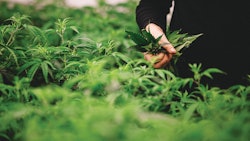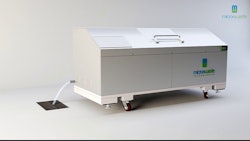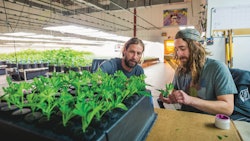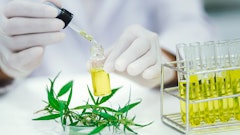
At its core, the purpose of potency testing is to demonstrate compliance, accurately label products and ultimately obtain a certificate of authenticity from an accredited third-party lab, according to Alexander Makowski, chief scientist at Sage Analytics.
Beyond the basics, though, regular testing can also help growers optimize potency in their crops, Makowski adds. Sage Analytics develops portable, laboratory-quality cannabis potency measuring systems, and on-site testing goes a step further by having the science at a grower’s fingertips and leading to fewer surprises in cultivation and production, Makowski says.
Potency testing tends to be a routine part of the of the job for cultivators, but how deeply do growers understand the process?
Here are some key insights to help cultivators better understand potency testing.
1. Various tools are available for potency testing.
Potency testing usually happens in an accredited third-party lab, using high-performance liquid chromatography (HPLC) or gas chromatography. The lab will divide a sample of cannabis bud or concentrate, dissolve it in a solvent, dilute it, heat it and pass it through separation columns and then into a detector. It is then compared to known chemical standards to measure potency.
“Effectively, they’ll get a vial of significantly diluted pure THC from a registered chemical company, like a Sigma-Aldrich or a Dow, and they’ll run that through the instrument, and they’ll say, this is what it looks like on the detection, which can be mass spectrometer, or it can be UV spectroscopy,” Makowski says.
The process requires a qualified chemist to ensure that all factors are handled properly, he adds.
“The benefit is—provided that it’s done properly—you’re comparing to a known standard and you can achieve extremely high accuracy and precision,” he says.
Each lab has its own methods, however, which they consider intellectual property. Different labs may get different results based on their processes, Makowski says. State regulatory bodies, such as California’s Bureau of Cannabis Control, have refined rules to achieve consistency between labs, and the International Organization for Standardization (ISO) has a standard for analytical testing and quantifiable materials that is used to vet and qualify methods used at labs. Each lab also has an accreditation agency that audits their methods and chemists.
“Working tightly with your lab as well as having in-house testing can help ensure that tests are both representative, and that everything is running smoothly on a day-to-day basis to minimize any changes in product output,” Makowski says.
Instruments available for in-house testing typically use spectroscopy to measure potency by analyzing the absorption of different colors of light that correspond to the type and quantity of chemical bonds, Makowski says. Growers can get results that are within a couple percent of lab results, and the sample is not destroyed in the process, he adds.
“You can do hundreds of tests and it doesn’t cost you anything—you don’t have the standards, you don’t have the chemicals, you don’t have to pay a chemist [and] anybody in your organization can do it,” Makowski says.

Sage Analytics' Beacon device is an example of an in-house potency testing instrument available to cultivators. Photo courtesy of Sage Analytics.
2. On-site testing is a miniature insurance policy.
Makowski cautions Sage Analytics’ clients that on-site testing will never replace traditional lab testing, as state regulations mandate that a third-party lab must test products and provide a certificate of authenticity. However, testing in-house is a way for the business to protect itself, he says.
“That’s a good thing for them to have because inevitably if something does go wrong, it’s like a mini insurance policy to say I did everything I could to make sure things go right,” Makowski says. “Especially because the legality of this industry is always in a constant state of flux, you at least want some paperwork and documentation, just so you’ve been doing your absolute best to make sure that you’re keeping things as safe as possible.”
On-site testing also ensures that cultivators send compliant and high-quality samples to labs, since they can closely monitor potency levels during each stage of the cultivation process, he adds. “You deal with anything that might happen on a day-to-day basis in-house to make your best possible product to send that off to laboratory testing to say someone else is going to validate what this is.”
The ability to test in-house can also help cultivators make more educated business decisions, Makowski says. If a vendor claims a piece of equipment can improve a crop, a grower can test for potency regularly to see if the equipment is truly improving the potency levels. Or, if a cultivator buys seeds that are supposed to be CBD-only with no THC, he or she can test them to confirm the claim.

Sage Analytics' Profiler II is another on-site testing option that measures THC and CBD within seconds, without destroying the sample. Photo courtesy of Sage Analytics.
3. Potency testing should measure THC and CBD in their active and acid forms.
Most potency tests measure the major cannabinoids, including the active forms of THC and CBD. However, cultivators should also test for the acid forms, THC-A and CBD-A, Makowski says. The acid forms are naturally produced by the plant and are more shelf-stable, but they don’t have the effects that consumers usually seek, and therefore must be activated and turned into their active forms.
“You have to activate those through a chemical process called decarboxylation, which is usually done through the heat of vaporization or smoking,” Makowski says.
During the extraction and manufacturing processes, there might be enough heat, pressure or chemical exposure that the cannabis could undergo decarboxylation and become active on its own, which is necessary when making edibles—otherwise, the end user would need to heat edibles before consuming them to get the desired effect.
“Some labs are also measuring a large slew of minor cannabinoids—this is like a business proposition or a value add,” Makowski says. “They’re pursuing potential benefits of compounds that are less studied and less known.”

An example of on-site potency testing results from Sage Analytics. Photo courtesy of Sage Analytics.
4. Testing often and on-site can help optimize the crop.
One of the key factors in the buying, selling and trading of cannabis has always been potency, and growers want to get the most potency they can from a crop, especially when investing in growing a difficult plant or a unique strain.
“These cannabis cultivators are looking to optimize their potency in many ways,” Makowski says. “They care about their nutrients, they care about the sunlight and quality of the light that they’re getting, the night/day cycle, … and then they use instruments like ours where they don’t have to send off to the lab to optimize their harvest. So, they can pull a couple buds, and when … the buds … are close to their optimum potency, they test with us every day before pulling down and harvesting a greenhouse or an acre of their outdoor grow.”
Having the ability to test on-site on a regular basis helps cultivators optimize their harvest or breeding experiments, allowing them to test how potency is affected by nutrients, water, light and other factors and constantly improving upon procedures to increase potency.
“A lot of these cannabis farmers are using testing as their in-house weapon to decide what is the best way to cultivate different strains differently to get their desired results,” Makowski says.
5. Accurate potency testing and labeling ensure proper dosing.
Potency levels are based on percent weight, and responsibly made edibles are subdivided with a milligram dose, Makowski says. For example, if a consumer purchases a chocolate bar, it is subdivided into sections and should be well-mixed, so the consumer can be confident that each section has a consistent dose.
When consuming flower, potency levels are equally important because they tell the consumer how much should be smoked to achieve the desired dose. Accurate potency testing and labeling on products also allows consumers to decide what an appropriate dose is because some people may have a high tolerance to cannabis or some patients may need more to deal with their medical conditions.
“And in some sense, there’s also an economic benefit for buy, sell and trade between cannabis companies because knowing this potency or percent weight … allows you to know, … how much am I going to get back out of that if I extract it? … How much do I have to put in something to make it an appropriate dose?” Makowski says.
Top Image: © nokturnal | Adobe Stock


























